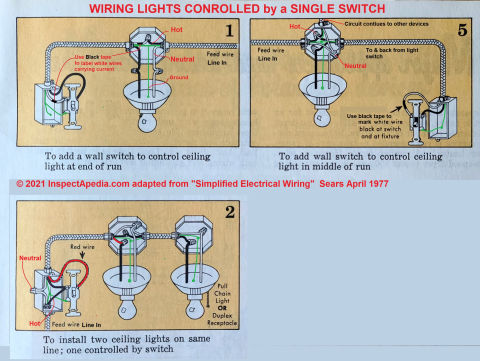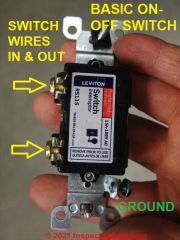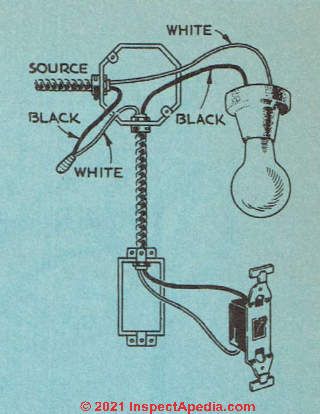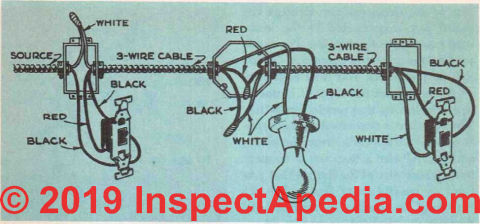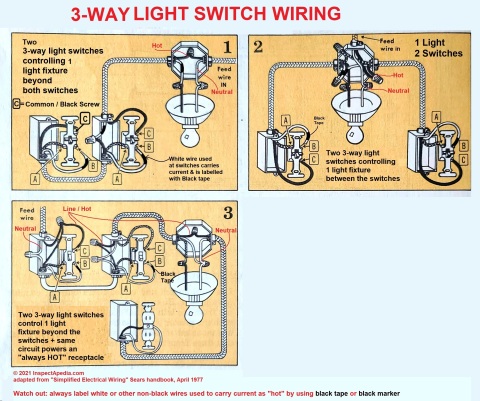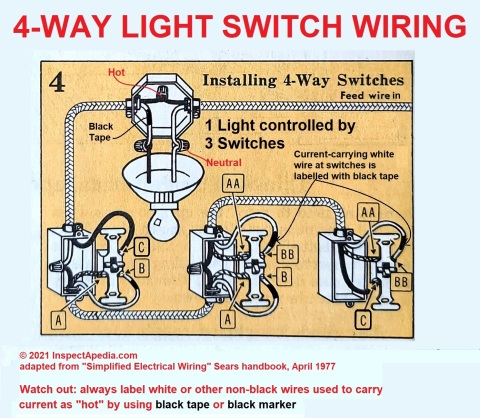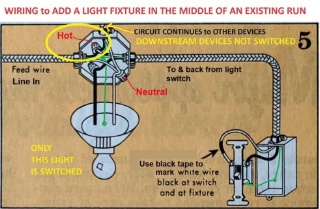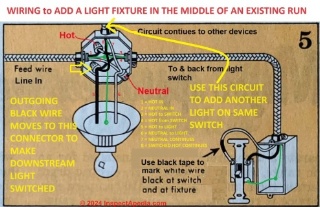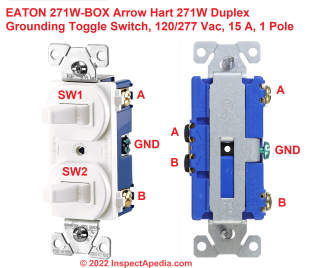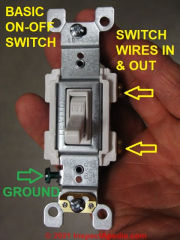 Light Switch Wiring How to
Light Switch Wiring How to
Identify wires, make light switch wiring connections,
single, 3-way or 4-way toggle switches
- POST a QUESTION or COMMENT about how to wire light switches, single, 3-way, 4-way
This article describes how to wire a simple on-off electric light switch, how to wire 3-way light switches to control lights from two locations, and how to wire 4-way light switches to control lights (or other devices) from three or more locations.
Our page top photo shows the wiring terminals on a simple on-off light switch used to control the fixture from one location.
InspectAPedia tolerates no conflicts of interest. We have no relationship with advertisers, products, or services discussed at this website.
- Daniel Friedman, Publisher/Editor/Author - See WHO ARE WE?
Light Switch Wiring Connections & Wire Identification
On 2021-05-29 by Anonymous - how do I wire this light switch?
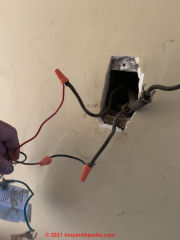 I’m removing this motion sensing switch and replacing / connecting it back the regular two way light switch on my old house that was built around the 1920’s.
I’m removing this motion sensing switch and replacing / connecting it back the regular two way light switch on my old house that was built around the 1920’s.
How do I determine the identification of the (3) wires coming out from the wall as to which is the (hot) (neutral) or (ground) wiring when that are all the same color?
Also on the switch i will be replacing it with the switch has more than (3) terminals to connect / replace the wires onto?
How do i know which wires go where?
[Click to enlarge any image]
On 2021-05-29 by (mod)
@Anonymous,
As you say your home electrical wiring dates from the 1920s and guessing that your home is in North America, it's possible that your electrical wiring does not include a ground wire, so the fabric or rubber colored wires in your electrical box would have been hot, neutral, and sometimes third wire used where 3-way light switches were installed - more on that later.
See details at ELECTRICAL GROUND SAFETY in OLD HOUSES
Which wires are Hot and Neutral?
Look very closely at those wires. Often thought they're all "dark" one of the fabric or rubber wires was originally white (neutral) and you may discover that by close inspection.
An electrician will typically use a test tool like a DMM or VOM to identify which wire(s) is (are) "hot" by testing for live voltage between wires and between wires and ground.
With power on the electrician uses a simple neo tester to touch between pairs of wire ends and between individual wire ends and a ground source such as a metal box (if it's grounded) or a water pipe.
See details at DMMs VOMs SAFE USE OF
Watch out: if you are not familiar with safe electrical testing and practices you can be shocked or killed just touching live electrical wires. Hire an electrician if you're not trained to perform this work safely.
Details about using a neon tester are at ELECTRICAL TOOLS BASIC where we discuss neon testers and similar simple test tools.
Wiring Connections for a Single Light Switch Controlling a Light Fixture
At a single light switch often there is an incoming "hot" to the switch and an outgoing "hot" from the switch to the light or other switched device. The third wire could be a ground, or the box in your photo could be for what was originally a 3-way light switch.
I'll use our updated version of some typical light switch wiring connection drawings, adapted from a 1977 edition of "Simplified Electrical Wiring" handbook that I bought from Sears in 1977 for 50 cents.
Watch out: live wires can shock or kill you. Turn electrical power to the circuit OFF before fooling with its wires, and use a neon tester or electrical test meter to confirm that power is OFF before handling electrical wires to a light or switch.
On a new basic on-off light switch there will be three terminals:
- LINE-IN (the hot wire),
- LINE-OUT (out of the switch to the light fixture, energized only when the switch is in the ON position) - these terminals are symmetrical so there may be no identification as "line" and "load"
- GROUND (circuit grounding conductor that for your case where the switch box is metal, should also be connected to the metal box)
Your new switch will -mark those wiring terminals both on the switch and on a wiring diagram included on or in the box.
Here are typical wiring details for a simple light switch, showing several situations
The simplest light switch wiring case is #1 in the drawing above.
- the "feed wire" brings hot, neutral and ground (ground is not shown here) into the light fixture.
- In the light fixture electrical box the neutral is wired to the light's neutral (white wire)
- In the light fixture box the incoming "hot" is wired to the white wire of a pair of wires white and black) that go to the wall switch.
- In the wall switch the incoming white wire is bringing current and is connected to one of the two switch power terminals;
- In the wall switch the black wire from that same pair is wired to the other switch power terminal (the two terminals may be marked on the switch as LINE IN and LINE OUT but are in essence identical otherwise)
Watch out: to keep from shocking someone else in the future, in a pair of electrical wires (white and black to a switch for example), when we are using the white wire to carry live current, we mark that wire as "hot" -
Sears said to paint the wire black but nobody on earth has ever actually done that. Instead the electrician simply wraps a bit of black electrical tape around the white wire near its end and where it is connected to a terminal on the switch or to a twist-on connector in the electrical box at the light fixture.
Illustrated below we see the whole circuit for switching an electric light from a single switch in an older circuit with no ground - this may be the case for your home.
Above, from our 1950s reproduction of "Build Your Dream Home" chapter on electrical wiring, you can see how simple is the wiring for a single light switch.
In your photo I only see two wires connected to your switch, though the photo and data are very incomplete. If only two wires were used and the switch previously turned the light on and off - and if there are no other switches for the same light fixture, then yours is a simple "on-off" light switch - as illustrated in the three examples in our light switch wiring drawings above.
Why are there 3 wires at my switch?
Because you have three wires at your switch and because I don't know if your wiring includes a grounding conductor or "ground wire" (in 1920's electrical wiring often there's no ground wire) it's possible that your switch was originally a 3-way light switch.
Shown below, from the same source, we show one example of why there could be three wires (or more) at your switch box: if the light was originally switched from two locations.
Fig. 50. As depicted above, when the fixture is located between the two three-way switches, three-wire cable must be used throughout.
The exact wiring details for a 3-way light switch vary depending on whether the light fixture is at one end or between the two switches.
Really? possibly none of the following about how to wire a 3-way light switch pertains to you. You will need to complete identification of all of the wires at your switch box, as we've described.
How to Wire a 3-Way Light Switch
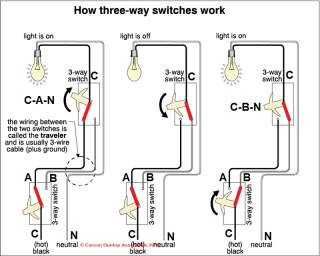 Three way light switches let us turn a device like a light on and off from two locations.
Three way light switches let us turn a device like a light on and off from two locations.
3-way light switches are needed for example at lights over stairs, so that we can switch lights on- or off- from either a switch at stair top or another switch at stair bottom.
A three-way light switch requires a 3-wire circuit plus ground in modern installations. One wire is the C or common wire, usually black, and the other two wires (A and B in our drawings) may be red and white (tape the white wire to indicate it's being used to carry current).
[Click to enlarge any image]
At a 3-way light switch there will be three incoming wires, ultimately turning on or off the light or other switched device, but working in conjunction with one or more additional 3-way light switches on the same circuit; with these switches flipping any individual switch will turn the device OFF if it was already on, or ON if it was already off.
This sketch illustrating how three-way light switches work is provided courtesy of Carson Dunlop Associates, a Toronto home inspection, education, and report writing tool provider.
A new 3-way light switch will actually have four terminals:
- Common terminal:
usually denoted by a black-colored screw as shown in our photo of a Leviton 3-way toggle switch, to which the line in or "hot" circuit black wire is connected on the first 3-way switch, and on the second 3-way switch this same black terminal is carried to the "load" side or in our example to the light fixture's black or hot wire. In our 3-way switch wiring schematic below the black or common switch terminal is identified as "C" - A terminal - traveler wire -
one of the switching wires - may be red or other colour - B-terminal - traveler wire -
the second switching wire - may be white (taped with black tape at each end) or other colour - Ground terminal:
usually green colored - not shown in our adaptation of Carson Dunlop Associates drawing above.
Shown below, from the same antique Sears 50-cent source, is a sketch showing four situations for wiring three-way light switches, (and in case 4-way light switches).
You can easily identify a 3-way light switch as instead of having just two terminals (LINE IN, LINE OUT) and a ground terminal, the switch will have four terminals.
And a 3-way light circuit will always require three wires (plus ground making the actual total four) that are used as we illustrate and describe below.
Take a look at case #1, the easiest to understand. Note that again for simplicity the original Sears drawings did not show a grounding conductor that might be present in your wiring and that should always be present in modern electrical wiring.
- The lighting circuit feed wire
brings a power (black or LINE) and a neutral wire into the electrical box where the light fixture is to be connected. - Circuit neutral to light
Right in the ceiling box for the light fixture the circuit white neutral wire is connected to the light fixture's neutral wire. - Circuit hot wire to 3-way light switch
But in the ceiling box the incoming power (black or LINE) wire continues out to the first three-way switch.
At a typical 3-way light switch you will see these wire terminals
- ONE terminal at one end of the switch - this gets the incoming hot wire
- TWO terminals at the other end of the switch - in essence an "either-or" switch as follows:
When the switch is in the "up" position the incoming hot wire is connected to one of the pair of other terminals, say terminal "A"
When the switch is "down" the incoming hot wire is connected to the other of the pair of "other" terminals, say terminal "B" - First of two 3-Way Light Switches: Box #1 (maybe at the bottom of our stairs)
When we are using 3-way light switches normally in at 3-way light switch electrical BOX #1 at 3-way light Switch #1 its pair of terminals A and B are wired over to the corresponding A and B terminals of switch #2. - Second of a pair of 3-way light switches: Box #2 ( (maybe at the top of our stairs)
In Switch BOX #2 and thus at 3-way light switch #2 , the 3-way light switch terminal C (the one that's by itself at one end of the switch is wired back to switch box #1 where it connects to the second (maybe white wire but labeled as "hot" by a bit of black tape) of the original pair of wires that entered box #1 from the light switch. - In the ceiling box for the light fixture itself,
you can see that same white wire (labeled as "hot" there too by another bit of black tape) is connected to the incoming or black or "hot" wire of the light fixture itself.
The original incoming line neutral wire connects to the white neutral wire of the light fixture
If there is a ground wire for your circuit that wire connects to the ground wire or screw on the light fixture and if the electrical box for the light fixture is metal, then that same grounding conductor is connected the metal electrical box body using a grounding screw or clip designed for that purpose.
With this 3-way light switch wiring schematic, either Switch #1 OR Switch #2 can turn the light fixture ON or OFF as needed.
Watch out: remember to use black electrical tape to mark as "hot" any white wires used to and from light switches and that are thus being used to carry current. You'll see I've added that annotation to the original drawings.
More illustrations and examples of wiring 3-way light switches are
at ELECTRICAL WIRING INSTALLATION BASICS
Wiring 4-Way Light Switches: Turn Lights On or Off from Three Locations
4-way light switches, wired a bit differently, are below and allow us to install three or more switches that all control the same light from different locations.
Follow the wiring connections from the C-terminal at the first light switch (lower left in our drawing) and you will see that in sum multiple light switches are daisy-chained and wired so that any of them can interrupt (turn off) or complete (turn-on) power to the light fixture.
...
Reader Comments, Questions & Answers About The Article Above
Below you will find questions and answers previously posted on this page at its page bottom reader comment box.
Reader Q&A - also see RECOMMENDED ARTICLES & FAQs
On 2024-05-01 by Joe - how do I add a second light to the same fixture
In your ; (Wiring Connections for a Single Light Switch Controlling a Light Fixture) section, I have what you show in diagram 5. I would like to add a second light to that could you explain to me how to go about that please, thanks.
On 2024-05-01 by InspectApedia Publisher
@Joe,
Now I've modified the wiring in the original light wiring diagram to make any "downstream" devices controlled by the light switch.
Light switch wiring diagram No. 5 in this article shows how we wire a switch to an existing fixture. In essence the added switch is interrupting the black or "hot" wire that comes into the junction box (labeled "Feed wire Line in" in the drawing.)
Notice that there is, at the top of the electrical box in our illustration, a wire set leaving the box, labeled in black "Circuit continues to other devices".
Wired as shown in the original No. 5 drawing, ONLY the local light is being switched on and off, not additional devices or lights "downstream" on that "\Circuit continues to other devices" wire. That's because the in the twist-on connector circled in yellow, we join the incoming hot wire, the white (taped with black) wire to the switch, and the black wire for the circuit continuing to other devices all together.
Next I'll post a modified version of that wiring that will allow the same switch to also control any additional devices, such as a light, that are on that downstream "Circuit Continues to other devices" wire.
The key change is at that twist on connector joining hot wires. We moved the hot wire that originally went from there directly to the downstream devices over to the hot-wire twist on connector coming FROM the light switch - marked by my yellow arrow.
Click to see the larger version of this image and you'll see that I've included 8 wire identification labels.
Watch out: if you are not trained and qualified in electrical wiring you could be shocked or killed or start a fire when working on electrical circuits.
On 2022-09-26 y Steve - how do I replace a light switch
In dining room there are two light switches in one how do I replace switch
You pull them out one has 3 hots 3 ground 3 common then leads over to other switch
On 2022-09-26 by InspectApedia (Editor)
@Steve,
It would be helpful if you could post a photo of the switch assembly - one photo per comment but as many comments and photos as you need -
When a light is controlled by two or more switches it's called a 3-way light switch. In essence each switch simply flips its connection between two wires.
When you have a duplex switch assembly that's switching two different things (lights, receptacles or something else) but each of those individual switches still has to be wired as an individual 3-way switch.
Above on this page we explain, illustrate and give details of exactly how to wire a 3-way or even a 4-way light switch.
Please take a look and let me know what further questions you have.
Shown below: 15 Amp, 120/277 Volt, Duplex Style 3-Way / 3-Way AC Combination Switch, Commercial Grade, Non-Grounding, Side Wired - White.
Each of those individual switches is wired as a 3-way light switch as given above on this page.
I've not encountered a light switch with three grounds so I am concerned that you've misunderstood the terminals on your switchContinuing, for completeness
Below we illustrate a simpler duplex switch, but each of these switches is a ** 1-way ** switch - that is, the switch is intended to be used as the only switch controlling a circuit such as a light fixture.On 2022-09-26 by InspectApedia (Editor)
@Steve,
Clarifying light switch grounding - U.S. NEC rules
When installing a NEW light switch the switch should be grounded - its ground screw connected to a circuit grounding conductor (ground wire).
When installing a REPLACEMENT for an existing light switch that was itself not originally grounded, the new switch doesn't have to be grounded, but
Whenever you are installing a light switch into a METAL electrical box the switch and the metal box should both be connected to a circuit grounding conductor.
Grounding connections are a safety feature. The circuit ground should have no role whatsoever in the actual functioning of the light switch.
Question: Is 14/3 wire ok to use to wire between the light switch and the light? What about an electrical outlet on the same circuit as the ceiling light fixture?
Is it okay to use 14/3 wire for power to light to switch to receptacle?
[Click to enlarge any image] Sketch at left provided courtesy of Carson Dunlop Associates, a Toronto home inspection & education firm.
Reply:
Anon:
If you are asking about using a shared neutral wire on a lighting circuit combined with an electrical receptacle circuit, see (search InspectAPedia.com for) our article on "multi wire branch circuits" or "shared neutral electrical wiring".
In general we'd use 14-2 wire on a 15 amp circuit to power electrical receptacles and a SEPARATE circuit to power the lighting fixtures. If we lose power on one circuit we want the other still working so that there is safe lighting in the area.
For a light fixture such as a ceiling light, in addition to bringing power to the junction box where the light fixture is to be mounted (using 14-2 copper wire) we'd use a separate length of 14-2 wire to run from the light switch to the junction box to control the light. Tape the white wire at both ends of the switch circuit with black tape so that the next worker knows that this is a switch circuit and that the white wire is not a neutral wire.Watch out: we do not wire fixed lighting fixtures such as ceiling lights on the same circuit as electrical receptacles ("wall plugs"). If one of the two circuits should be switched off by a circuit breaker (perhaps detecting a fault or overcurrent) we want the other circuit to remain on so that room occupants are less likely to be left in darkness.
Reader Question: how do I wire multi-way light switches so that all switches can be "down" or "up" when the lights are all off.
How should multiple way light switches be wired so that when all switches are down/up the light is off? Only some of the two-way switches in the house are working that way. With the 3-way and 4-way there's always one switch that has to be opposite the others.
Thx, Jim
Reply:
Jim this is one of my favorite questions - thanks. Because a circuit with two or more "three-way" switches installed can be turned on or off from any of the switches on the circuit, it is impossible to wire the circuit so that when the circuit is "OFF" all of the switches are in a predictable position, say "down" (which we like to use to mean "off").
Imagine that all the switches are "down" and the lights are off (which is a possible case). Someone turns the lights ON at switch #1.
When someone wants to turn that light OFF, IF and ONLY IF that very same switch (now in the "up" position) is used, then by definition they are going to be using some other switch (now in the "down" position). When that "other" switch is used to turn lights off, it was "down" and is now switched "up".
You can't get there from here on a conventional 120V 3 or 4 or n-way lighting circuit.
On 2019-09-19 by crystal - You should NOT just re-connect all of the wires at your light fixture before knowing what each wire does
so in the light fixture in my basement it has 4 hot wires and a nuetral wire connected to the hot wire for the light fixture. the light fixture fell and broke my question is do i need to replace that light fixture or can i leave it and just connect those same wires with a connector?
On 2019-09-20 by (mod) -
Crystal:
Watch out: regarding "a neutral wire connected to the hot wire for the light fixture."
Really? if so your wiring is incorrect and dangerous, risking fire or shock.
But it's possible that you're seeing a black and white wire pair that were used to wire the light fixture through a separate light switch, perhaps mounted on a wall.
You should NOT just re-connect all of the wires at your light fixture before knowing what each wire does, or you might find that you've wired hot to neutral (creating a short circuit) or you may have accidentally wired a switch into a circuit powering other devices that ought not be flipped off.
Most likely sorting this out is trivial, quick, easy. But ...
I am sorry to say - as I understand there are costs involved - but you need an electrician or at least someone trained in wiring and circuit tracing to examine the circuit and wires involved. It's just not safe for anybody to tell you it's ok to just reconnect a bunch of wires arbitrarily.
On 2019-02-19 by Larry M Fox - ceiling lights in my bedroom will flash on with the power off?
Hello, The ceiling lights in my bedroom will flash on with the power off? At first I thought it was a reflection of lights outside someplace bouncing off the glass of the lights, But now I have noticed it several times.
My wife has also seen this. One night in the bathroom (the bathroom is also part of the bedroom) the lights got real bright and then went off. I could only see the light thru the door so I did not see the bulbs themselves. Again, I want to make sure I describe the problem correctly.
We have 4 can lights in the ceiling. With the power off on the wall switch, these lights will flash on for 1 second or so. They do not light up all the way, only dim. And
I believe that not always will all 4 come on, but I cant be sure because I am lying on in bed on my side so I don't always see all 4. All this with the power off! the house was built in 1996-97. If that helps. My email address is globalmfg3@aol.com
Thank You
On 2019-02-19 by (mod)
Larry
Thoughts on diagnosing flickering recessed lights in a ceiling
I suspect a loose connection, perhaps at the light switch, would be worth investigating - or just replace the switch.
It would also be diagnostic to know the type of bulb installed in the lights.
Last, as these are apparently pot lights or recessed lights set into the ceiling, it's worth noting that recessed lights are of two types:
1. older conventional recessed lights that were NOT rated to be covered by insulation and an overheat - a fire risk - if insulated
2. newer lights rated DCIC (Direct Contact with Insulated Ceiling) that include a thermal sensor that will turn off the light if too hot. I speculate that a hot light anywhere in the group could also act like a loose wire and might flicker as a warning sign.
In a 1996-1997 home, DCIC lights may well have been installed. A defective thermal protector switch, usually mounted on top of the light canister, can be replaced if needed.See details at ELECTRIC POWER LOSS / FLICKERING LIGHTS
On 2019-12-08 by Anonymous - extra cost to install light switches?
is it code that the electrician must install switches for lights
he trying to charge me extra for the switches to be installed
On 2019-12-09 by (mod)
Anon:
That sounds absolutely crazy. What does the electrician think? That after he leaves the job, lights will stay on for the rest of the life of the house?
Of course lights must be switched, and in some locations such as stairway lighting switches must be provided at both top and bottom of the stairs.
What was the original bid for work? Was it in writing?
On 2019-09-14 by Jason
My mother's boyfriend was working on a light switch in the back room he crossed wires somewhere in the box now there's no power to the switch all but one outlet is ok
the bedroom before that meaning closer to the panel it has same issue
my problem locating anything is when he started this he also put in New panel but didn't list what circuits went to what room I think he caused a short how could I find it without ripping out to much of wall or ceiling or both. Thank you
On 2019-09-14 by (mod) -
Jason
LIGHT SWITCH WIRING DETAILS describes the wiring connections for lights and their switches.
ELECTRICAL CIRCUIT ID, MAP & LABEL describes methods for tracing electrical circuits. Let's start there, and let me know what further help is needed.Also see this
NAVEDTRA BLUEPRINT READING GUIDE [PDF] Original source: https://seabeemagazine.navylive.dodlive.mil/files/2017/11/NAVEDTRA-14040A-Blueprint-Reading-and-Sketching-Part-2.pdf
On 2019-03-11 by Lucy
I have closets with lights that turn on when a cord is pulled. I want to install a light with a light switch to turn it on and off. How do I do this? My building has the old wiring.
On 2019-03-12 - by (mod) - closet light switch
Your electrician, after confirming that the light as located is not already a fire hazard, will interrupt the hot wire in the light fixture box by running wires down to the switch box. She may also need to install a larger electrical box for the light to accommodate the added switch wires.
Search inspectapedia.com for CLOSET LIGHT FIRE CLEARANCE for more details.
On 2017-11-20 by Arleen Young - snapping buzzing crackling electrical sounds in a 1993 Crimson Mobile Home
Hi ive been reading jumping round passing some stuff up till i got to the questions and or comments. my story is too long to tell so im guna give the basics to wats going on. Im in a 93 model crimson mobile home and it has coppr and aluminum wiring and the breaker box is a Siemens.
i believe this home was put together to quickly and sloppy. And just last mth my husband had finally replaced the kitchen ceiling light fixture.
The old one strtd to give problems and the long bulbs didnt wana come on anymore and my stupid self was steppng on a stool to stand on the sink counter messing with the bulbs so i could hve light to cook ect...
And u could hear the balster box on the end buzzng and crackng when u try to push and twist the bulb. It finally got so bad i said no more and had to put to lamps in the kitchen with no shade so i could c
. So he finally went to Lowes and bought an all LED fixture but ever since he installed it theres ben popping and crackng noises that move around just in the kitchen area and sometimes are very loud and hard! Im not liking this at all!!! Ive ben saying somethng for awile now and he hears it too but just acts like he doesnt care. Ive just purchased 5 new smoke alarms and placed them thru out the home.
Cuz the only one that was in here had burned up/caught fire not long aftr getting the home eith his first wife. Luckiky they were here. To put it out butnever replaced it.
Thers a exstinguisher but its as old as the house dont know if itll wrk.
But also 3or4 light switches hve quit wrkng and the breakers 1 or 2 dont kniw which ones occasionally click off for now reason.
And it seems like the noises happen more when u click on the heater furnace. The air unit outside had quit wrkng several yrs bak so thers window units and the larger 1in livingroom when it was running this summer would make the power and lights click on and off real quick when the compressor kickd in!
And 2or3 times really more than that weve had power surges where the power would click off and back on again sometimes 2twice in one day! Im not able to sleep hardly cuz im afraid its guna catch fire and im in the master bdrm with the breaker box and 2sm windows and one big 1 with air window unit in it which i would jus throw stuf out of the way and kick the unit out with my foot to get out if im awake!
But ive got 3 animsls id hve to retrieve too. 1s with me a cat old cat and then my german shepherd who sleeps in livingroom most the time and the othr cats in and out. And the ole man sleeps up in front bdrm where he can be out in no time! But when i touch the breaker box its warm to the touch and the breakers r too. But not that bad really.
But like today the power flinched and he said he heard a poppng noise come from the midfle bdrm close to his. But he never chks anythng out. So can u tell me how much danger am i in?!
Does this trailer sound like its a death trap like i think it is?! Plz give me some advice. But i am callng around for an electrician thatll come give a free estimate today , monday! Right b4 Thanksgiving when ill b cooking. And when i hve to leave to go somewhere i turn the main breaker off to the whole house cuz of the animals. I dont wana lose them to a irresponsible guy.
Whos lazy. Will wrk his ass off at his job that he wrks with under ground utilitys and sewage. But wont do nothing at his home! Dsnt mke since too me. Anyway i turn the breaker off cuz after about 30 mins the popping stops. Cuz i chkd it out one day listening to it decided to see if it would stop. And it did. Then aftr 35mins clikd it bak on and it took about an hour b4 i heard the noises again. But that was a mth ago.
When i clik it bxk on it dont tke long to strt again! Ok im done! Hope to hear bak soon! Thanks, Arleen Y
On 2017-11-20 - by (mod) - buzzing crackling electrical connections - mobile home light switch failures
Arleen,
Watch out: What you describe indeed sounds unsafe, risking a house fire. Buzzing, crackling noises in electrical equipment is usually an immediate red flag that means you want to turn OFF such misbehaving circuits right away, then get help from a trained, licensed electrician.
The problem could be
- improper wiring connections
- defective circuit breakers that don't trip
- presence of aluminum wiring
- or something else, perhaps one of the items discussed at POPPING SNAPPING NOISE DIAGNOSIS
I understand doing your own wiring is more affordable, but a mistake can kill you or burn down the house or both. So unless you or hubby are trained and comfortable fixing wiring I'd not do it.Also see LIGHT SWITCH WIRING DETAILS
On 2017-09-21 by Kathy
My husband and I drywalled a door opening and created an entryway on the adjacent wall. My husband ran the wiring from the wall on the left side of the door we removed to the right side of the door we removed
. On the left side was a wall switch with three switches and on the right was a single wall switch. before we drywalled the previous doorway, he ran the wires through the framing to connect the circuit to the other wall. In other words, imagine you closed in a doorway and ran the electric to the wall on the other side of the door.
Well, my husband just died before he had a chance to connect the wires together and now i dont know how to complete the circuit.
On one wall i have two working switches, and a white cord containing hot, ground and neutral wires whixh are open, not connected to anything.
On the other side of the wall is a light switch that doesnt work. Both hots are connected to the switch.
The neutrals and grounds are connected with yellow twist caps. According to my husband, all he had to do was connect the open wires on the other side and the single non working switch would work. But he never did it and now I cant afford an electrician and I dont know what to do.
Can you figure this out? Thank you in advance if you can
On 2017-09-21 by Kathy
I am, of course sorry that you've lost your husband and electrical wiring expert.
If knowing the connections for wiring a light will help you out, details are
at LIGHT SWITCH WIRING DETAILS
Let me know how you're doing
On 2017-05-15 by Karen Garber - re: best location for a light switch
PLEASE HELP with indoor wiring and switch requirement for outdoor lights. We are senior citizens:
I want an outdoor light on the left side of my front door but my electrician will not do it because the switch is on the opposite side of the door inside the house. He said that it is not code to have the switch on the opposite side of the door.
The light was there before but he took it upon himself to move it.
I think he is just annoyed that we are asking him to change it because he said NO lights or 1 on each side of the door. If he is bringing a wire across the top of the door to power a 2nd light then why can't I have just one light on the side that I want?
I have to add that there is no sheetrock by the front door now and we want to do the right thing before the walls go in. I appreciate any information.
On 2017-05-15 by (mod)
Karen,
Generally it makes sense for a room light switch to be located where it would be readily accessible when entering or leaving a room. The swing of the door means you wouldn't prefer a switch by the hinge side of the door.
If your electrician says what you want is illegal or unsafe, despite my sincere wish to be helpful, I'd be really foolish to pretend I could out-guess an on-site licensed expert. But you could certainly give a call to your local building department, ask to speak to the electrical inspector, and without leveling any accusations, just ask what the local code enforcement people where you live - the final legal authority - will permit.
On 2017-02-22 by Wayniac
Albert, probably be a good idea to look up a common wiring diagram to show how a switch is wired into a circuit. It'll make sense when you see it.
On 2017-02-23 by (mod) -
Thanks for the comment, Wayniac
It's a simplest possible device - two wires, two screws plus ground; Albert's circuit is already in place.
Roughly and not to scale, logically it's
black wire
from lighting
circuit
|
|
|
SWITCH
|
|
—————> LIGHT <—— white wire from lighting circuit >See details now above on this page.
On 2017-02-22 by Albert
I have just two wires (black & white) coming out of the wall to a light switch.The black and white are on the switch!
That's it! I took them off the switch and put them together(yes the black and white) and the light came on! What the heck kind of wiring is this and what do I do? I was needing to come off the hot side of the switch to install a plug receptacle.... someone please help! I've never seen this before!
On 2017-02-22 by (mod) -
Yep. Often the electrician runs a two wire pair to the switch so one of them might be white in color. A sharp electrician wraps a bit of black electrical tape near the end of the white wire to tell future workers that in truth the whole circuit is one "black" wire (hot) being interrupted by the switch.
On 2016-12-30 by Bellakota
I have a 1970 mobile scout, and only the white light switches work. What could be the problem?
On 2016-12-30 by (mod) - only the white light switches work
Bella,
I'm unclear on what are "white light switches" - perhaps you mean the lights work but other electrical devices such as wall plugs (receptacles) do not?
Check for a blown fuse or tripped circuit breaker. If the problem occurs again, leave off the mis-behaving circuits as there is a fire or shock hazard - and ask forhelp from a licensed electrician. Keep me posted.
Question: placement of a light switch downstream from a GFCI
(Jan 2, 2015) curious said:
Can a light switch be placed downstream (load side) from a GFCI outlet to protect the 15a grounded outlet in a porcelain light fixture?
Reply:
An electrician can certainly place a switch in a "outlet" (they say receptacle) circuit but I'm unclear on why that switch protects a light fixture.
If you are powering the light from the same GFCI protected receptacle circuit (which is done in some cases) then if the switch and light are downstream from the GFCI and properly wired they should be receiving GFCI protection as well.
Reader Question: n-way light switch wiring
I have one line with power coming into a box that will have one two way switch, one three way switch and one power line exiting. Is it proper to splice the incoming black wire to make 3 black wires by pig tailing with wire connectors and doing the same for the white wire and ground? - is it ok? 12/13/12
Reply:
I'm sorry but I'm confused by the question. I think it's safe to say that in general it's common practice to use a twist-on connector to splice pigtails or individual wires at an individual hot or neutral wire where more connections are needed than fit with the original wire.
Just watch out to avoid violating the space or number of connectors permitted in a junction box of the particular size you're working on.
Question: I've lost electrical power to the whole room after testing power at the light switch
I've lost elec to the whole room.
I tested the wiring at the light switch.
If I turn the switch off I get elec to the switch,If I turn it on I get no elec.to the switch. I've lost electricity to the whole room - Dave
Reply:
Dave, your wiring or perhaps the switch itself is unsafe; sounds as if it's shorted. Leave the circuit off until the wiring has been traced, lest you start a fire or zap someone.
Question: where to buy plastic item that holds switches in the on or off position: source of switch locks for light switches
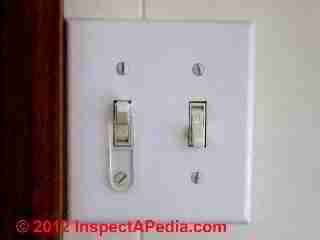 (Oct 7, 2015) Dick Lavender said:
(Oct 7, 2015) Dick Lavender said:
About your article "Exterior Lighting Installation, Inspection, Troubleshooting and Repair".
The section "Surface -Mount Outdoor Light Fixture Installation" has two pictures. The one on the right shows a faceplate and two switches.
I have looked all over (it'd seems) for the little plastic item that connects to the faceplate by the screw and holds the switch in the up position.
Please, do you know of a source of these little plastic items. I am excited to see the picture.
Dick Lavender
lav2@bellsouth
336-282-5116
Photo: clear locking tab holds light switch in desired position, on or off, but is easily loosened or removed if switch needs to be operated.
Reply:
Dick:
I purchased those little plastic switch-locks in the electrical department at Home Depot
but I'm sure you can find them at Loews, and you should be able to find them at your local electrical supplier - or online.
The device I like is made by Hillman Companies and sells for less than $2.00. Look for "Hillman Companies 42184 Switch Lock Clear"
...
Continue reading at ELECTRICAL WIRING BASICS, or select a topic from the closely-related articles below, or see the complete ARTICLE INDEX.
Or see these
Recommended Articles
- ANTIQUE LAMPS (BULBS) & CONNECTOR TYPES
- BACK-WIRED ELECTRICAL DEVICES
- CEILING LIGHT FIXTURE INSTALLATION
- DMM DIGITAL MULTIMETER HOW TO USE
- ELECTRICAL OUTLET, HOW TO ADD & WIRE - home
- ELECTRICAL SPLICES, HOW TO MAKE
- ELECTRICAL WALL PLUG WIRING ID & CONNECTIONS
- ELECTRICAL WIRING BASICS
- ELECTRIC POWER LOSS / FLICKERING LIGHTS
- FLUORESCENT LIGHT REPAIRS
- KNOB & TUBE WIRE IDENTIFICATION
- LIGHT SWITCH WIRING DETAILS
- LIGHTING, EXTERIOR GUIDE - home
- LIGHTING, INTERIOR GUIDE - home
- LIGHTING OVER STAIRS & AT EXITS
- LOW VOLTAGE LIGHTING & CONTROL RELAYS
- OLD HOUSE ELECTRICAL SYSTEMS
- REPAIR AUTOMATIC OUTDOOR LIGHT FIXTURE
- SAFETY for ELECTRICAL INSPECTORS - home
- SECURITY / MOTION SENSOR LIGHT INSTALL
Suggested citation for this web page
LIGHT SWITCH WIRING DETAILS at InspectApedia.com - online encyclopedia of building & environmental inspection, testing, diagnosis, repair, & problem prevention advice.
Or see this
Or see this
INDEX to RELATED ARTICLES: ARTICLE INDEX to ELECTRICAL INSPECTION & TESTING
Or use the SEARCH BOX found below to Ask a Question or Search InspectApedia
Ask a Question or Search InspectApedia
Try the search box just below, or if you prefer, post a question or comment in the Comments box below and we will respond promptly.
Search the InspectApedia website
Note: appearance of your Comment below may be delayed: if your comment contains an image, photograph, web link, or text that looks to the software as if it might be a web link, your posting will appear after it has been approved by a moderator. Apologies for the delay.
Only one image can be added per comment but you can post as many comments, and therefore images, as you like.
You will not receive a notification when a response to your question has been posted.
Please bookmark this page to make it easy for you to check back for our response.
IF above you see "Comment Form is loading comments..." then COMMENT BOX - countable.ca / bawkbox.com IS NOT WORKING.
In any case you are welcome to send an email directly to us at InspectApedia.com at editor@inspectApedia.com
We'll reply to you directly. Please help us help you by noting, in your email, the URL of the InspectApedia page where you wanted to comment.
Citations & References
In addition to any citations in the article above, a full list is available on request.
- Our recommended books about building & mechanical systems design, inspection, problem diagnosis, and repair, and about indoor environment and IAQ testing, diagnosis, and cleanup are at the InspectAPedia Bookstore. Also see our Book Reviews - InspectAPedia.
- In addition to citations & references found in this article, see the research citations given at the end of the related articles found at our suggested
CONTINUE READING or RECOMMENDED ARTICLES.
- Carson, Dunlop & Associates Ltd., 120 Carlton Street Suite 407, Toronto ON M5A 4K2. Tel: (416) 964-9415 1-800-268-7070 Email: info@carsondunlop.com. Alan Carson is a past president of ASHI, the American Society of Home Inspectors.
Thanks to Alan Carson and Bob Dunlop, for permission for InspectAPedia to use text excerpts from The HOME REFERENCE BOOK - the Encyclopedia of Homes and to use illustrations from The ILLUSTRATED HOME .
Carson Dunlop Associates provides extensive home inspection education and report writing material. In gratitude we provide links to tsome Carson Dunlop Associates products and services.


